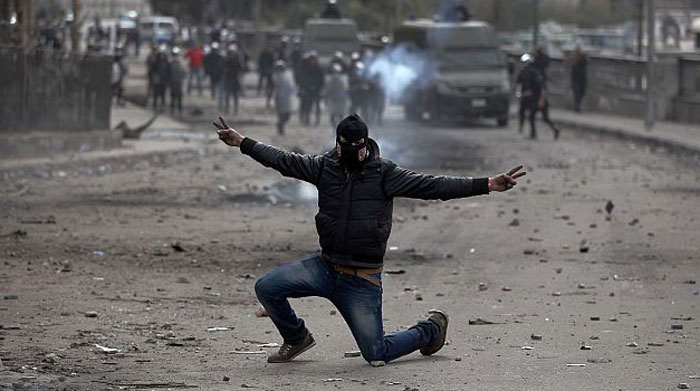Egypt: Revolution Continues, from Streets to Alleys

What happened on the fourth anniversary of Mubarak’s downfall and the victory of popular uprisings in Cairo and other cities of Egypt showed a repetition of the scenes which occurred before the downfall of Mubarak. These demonstrations led to armed conflicts and killed 20 people and wounded 100. These reactions were simultaneous with the freedom of Mubarak’s sons and his exoneration. These events showed that after four years and many developments, the previous equations still rule Egypt today in a new form. The freedom of Mubarak’s sons indicates the nature of the present government well. It also shows that the present government has no contradiction with the former Egyptian dictator and his sons whose financial corruption was obvious to all. This is exactly the point which separates people from the government. Four years ago, on January 25th, people had reached a consensus about the illegitimacy of Mubarak’s regime. They believed that during Mubarak’s regime there was corruption and freedom was limited and his foreign policy did not bring pride for the country. A look at the people’s demands during the past four years shows their dissatisfaction. People believe that conditions have worsened in two areas:
- Constitution: Contrary to all constitutions of the world, military officials have allocated special financial, economic and political rights for themselves.
- Arresting Muslim Brotherhood members: The number of Muslim Brotherhood prisoners was small before but now, 16000 members of the Muslim Brotherhood are imprisoned. This shows the similar nature of the present government with the previous one and would create more dissatisfaction among people.
There are considerable points regarding the recent demonstrations of the people on January 25th. Secular, nationalist groups and personalities like el-Baradaei were not present in these protests. Nonetheless, what happened were not vast street protests; they happened in the alleys. The reason was that the big streets were blocked by the police. Alleys were filled with unsatisfied people who had no party inclinations. Although it was said that these people were supporters of the Muslim Brotherhood, they were all opponents of the present government. The experiences of the past four years show that the conservative and compromising parties have left the scene of the popular movement. This is what can be observed in this confrontation.
What can be said is that the simultaneity of the phase of the regime’s collapse and the phase of the establishment of the new government has complicated Egypt’s revolution. People still feel that the authoritarian Mubarak regime has not fully been dismantled and even repaired and a new Mubarak has come to power.
Usually the most loyal people in the army hold high positions especially the head of army intelligence who is very loyal. That is why al-Sisi, who was the head of the army’s intelligence and was the most loyal friend of Mubarak, was chosen to rule this country. Therefore, there is no hope for further collapse of the former regime. What is happening is the continuation of the revolution in another revolution. In political culture, there is the term of “continuation of revolution”. It means that when a revolution achieves its first successes, revolutionaries attempt to complete the collapse through their plans. But this plan has moved on the opposite path. What is written in the new constitution as the road map for the new system is worse than the past. Today, revolution is on the shoulders of two groups:
- Universities: Universities have been closed half of the time and were the centers of anti-dictatorship movements.
- Masses of people: These people are not affiliated to any group or party.
The present movement of the people indicates the entrance into similar movements to classic revolutions. There is strong potential for revolution among the two supporting and opposing poles. There are serious differences between those who seek change in the political system in Egypt and those who pursue the stabilization of the present conditions. These differences seem difficult to be resolved. On the other hand, Egypt’s government attempts to hold parliamentary elections. But as Hassanein Heikal had warned a month ago, conditions are not ripe for the government to be able to eliminate the potential of revolution through guided parliamentary elections.
Today Egypt is under a series of developments. The people of Egypt, particularly the youth – half of the 80 million population of Egypt are under 25 years old – do not tolerate the past structure and the youth form the revolutionary forces.

